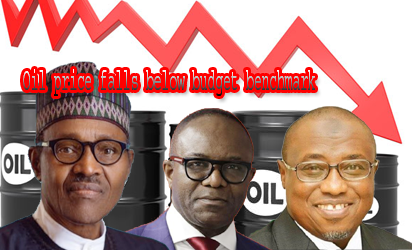
President Muhammadu Buhari, Minister of Petroleum Resources, Ibe Kachikwu, Ministe of State, Petroleum Resources and Maikanti Baru, Group MD, NNPC
Data from the Organisation of Petroleum Exporting Countries, OPEC, shows that prices are still trending down hitting a new low of $59.96 per barrel yesterday. The new price is now below Federal Government’s budgeted benchmark of $60 for 2019 Budget.
Consequently, the budget already sent to the National Assembly is now facing a review even before it is considered and debated.
The first casualty is expected to be the Nation’s excess crude account, ECA, which the National Economic Council (NEC) said stood at over $2.09 billion as at October 16, 2018.
Consequently, capital expenditure, which form the major thrust of the 2019 budget and the MTEF as well as the Economic Reform and Growth Plan, ERGP, of the present federal government may suffer downward review.
Why oil prices are on downward trend
Several factors are said to be in play. In particular, there are signs that supply glut is building up. The shale fracking industry is generating more supplies, as Iran’s production is still getting to the markets thanks to US sanction waivers. OPEC, the producers’ cartel, is likely to vote to cut production when it meets next month. That expectation is not providing much relief now, though. Oil is also being hit by the general drop in asset prices this autumn, and is suffering from fears that the global economy will slow in 2019.
The overhang from swelling US inventories which remain freshly minted in traders’ minds, suggests the massive crude glut continues to outweigh OPEC output cut although tentatively curbing traders downside ambitions. The global oil and gas sector was said to have lost about $1 trillion in value over a 40-day period since October after crude prices fell by about $20 per barrel. U.S.-listed companies in the Standard and Poor’s 500 shed $240 billion. ExxonMobil, for instance, lost $35 billion in value.
FG to revoke licenses of oil firms over gas flaring
Some analysts warned that OPEC will need to cut output to balance the market. “If they don’t cut, I guarantee you it’s going to be 2014 all over again,” Mike Bradley, Managing Director at the energy investment firm Tudor, Pickering, Holt and Company, said. Also speaking, former Chairman, Petroleum Technology Association of Nigeria, PETAN, Bank-Anthony Okoroafor said, “OPEC Members are committed to achieving market stability because they are already looking at cutting this oversupply by 1 million to 1.5 million per days during their December meeting. Saudi and Russia are also looking at major cuts per day. These will definitely help to address this low price of crude oil.”
The nightmare from Texas
An infestation of dots, thousands of them, represent oil wells in the Permian basin of West Texas and a slice of New Mexico. In less than a decade, U.S. companies are known to have drilled 114,000. Many of them would turn a profit even with crude prices as low as $30 a barrel. OPEC’s bad dream will only deepen next year, when Permian producers expect to iron out distribution snags that will add three pipelines and as much as 2 million barrels of oil a day.
“The Permian will continue to grow and OPEC needs to learn to live with it,” said Mike Loya, the top executive in the Americas for Vitol Group, the world’s largest independent oil-trading house. The U.S. energy surge presents OPEC with one of the biggest challenges of its 60-year history. If Saudi Arabia and its allies cut production when they gather December 6, 2018 in Vienna, higher prices would allow shale to steal market share. But because the Saudis need higher crude prices to make money than U.S. producers, OPEC can’t afford to let prices fall.
OPEC moves to combat declining oil prices
As uncertainty beclouds the future of crude prices, OPEC is set to decide on how to cut crude supply in order to forestall further declines in price. Saudi Arabia specifically is clamouring for an immediate cut by OPEC producers to a daily output of one million barrels starting early next year. In the meantime, Saudi Arabia said it is taking the lead by cutting its output to 500,000 barrels a day come December. The move is aimed at stabilising crude prices which have declined rapidly in recent times, thereby affecting the finances of OPEC members and global oil companies. Meanwhile, analysts believe OPEC, led by Saudi Arabia, of course, “is acting responsibly by reducing its production that it had earlier brought online to offset possible Iranian losses.”
Vanguard








0 Comments